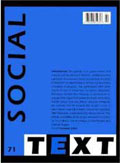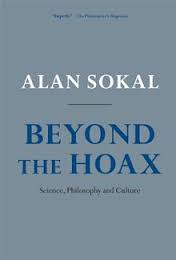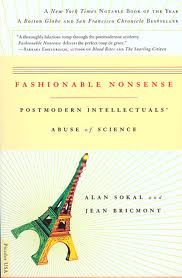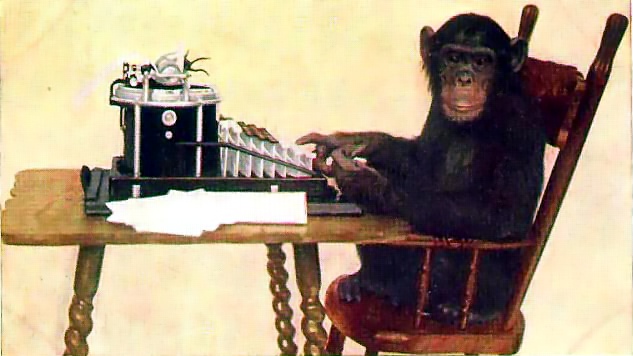 Over the course of the two preceding posts, I responded to the manifesto-cum-instruction-manual How to Talk About Books You Haven’t Read by Pierre Bayard (2007), in which, as I wrote, “the author argues in favor of a spirited discourse about literature untrammelled by antiquated notions of any pesky obligation to actually read the books under consideration.” My analysis of Bayard’s argument led me to conclude that his project in this treatise constitutes “an energetic advocacy of [what we once called] talking through one’s hat.” Or, to put it more bluntly, bullshitting. (For more on that subject, see On Bullshit, philosopher Harry G. Frankfurt’s little gem from 1986.)
Over the course of the two preceding posts, I responded to the manifesto-cum-instruction-manual How to Talk About Books You Haven’t Read by Pierre Bayard (2007), in which, as I wrote, “the author argues in favor of a spirited discourse about literature untrammelled by antiquated notions of any pesky obligation to actually read the books under consideration.” My analysis of Bayard’s argument led me to conclude that his project in this treatise constitutes “an energetic advocacy of [what we once called] talking through one’s hat.” Or, to put it more bluntly, bullshitting. (For more on that subject, see On Bullshit, philosopher Harry G. Frankfurt’s little gem from 1986.)
In passing, I made mention of Alan Sokal’s classic, still-controversial piss-take on postmodern jargon and the pomo pretense of “doing science.” This merits some elaboration, especially because, despite the international furore that erupted in the wake of Sokal’s intervention, you’re unlikely to meet anyone “doing theory” or teaching it who includes the Sokal hoax in the syllabus.
 In brief, back in the ’90s Sokal, a professor of mathematics at University College London and professor of physics at New York University, became acquainted with an assortment of purportedly classic postmodern texts in the area commonly referred to as “cultural studies” ― works by such figures as Jacques Derrida, Luce Irigaray, and Jacques Lacan. Noting therein a plethora of uninformed and erroneous references to scientific concepts, Sokal conceived of an experiment. Could he write a pseudo-scientific article filled with scientistic gibberish masked by postmodern buzzwords and tropes, ostensibly buttressed by endnotes referencing the usual postmodern authorities, and get it published in a prominent journal of postmodern “thought”?
In brief, back in the ’90s Sokal, a professor of mathematics at University College London and professor of physics at New York University, became acquainted with an assortment of purportedly classic postmodern texts in the area commonly referred to as “cultural studies” ― works by such figures as Jacques Derrida, Luce Irigaray, and Jacques Lacan. Noting therein a plethora of uninformed and erroneous references to scientific concepts, Sokal conceived of an experiment. Could he write a pseudo-scientific article filled with scientistic gibberish masked by postmodern buzzwords and tropes, ostensibly buttressed by endnotes referencing the usual postmodern authorities, and get it published in a prominent journal of postmodern “thought”?
The result, which he titled “Transgressing the Boundaries: Toward a Transformative Hermeneutics of Quantum Gravity,” was submitted to and indeed published in just such a forum, the highly reputed Social Text. It appeared in issue #46/47, pp. 217-252, spring/summer 1996, an issue devoted to what the editors described as the “Science Wars.” Spoiler alert: standing atop a veritable mountain of postmodernist clichés, Sokal proposes therein that the force we call gravity is merely a social consensus, among other ridiculous notions.
Once the article appeared in print, Sokal blew the whistle on himself and the editorial crew at Social Text, revealing the parodic nature of his hodgepodge in a subsequent essay, “A Physicist Experiments with Cultural Studies,” published in the journal Lingua Franca. This generated an uproar that ― fed by subsequent publications by Sokal, often in collaboration with Jean Bricmont, a Belgian theoretical physicist, philosopher of science and professor at the Université Catholique de Louvain, Belgium ― continues to this day. (The academic left does not take kindly to its debunking, to put it mildly.)
You’ll find many of the relevant texts, including Sokal’s germinal hoax in its entirety as well as his disclosure thereof, at his New York University website. I commend them to you, as I do the first Sokal-Bricmont book, Fashionable Nonsense (1998) and its successors. No specialized knowledge of science required, and extremely readable to boot. Fun, in fact.
I bring up the Sokal affair, as it’s often called, to point out the longevity and pervasiveness of the insidious idea promulgated by Bayard, his confrères in the academic world, and their fellow travelers inside and outside the ivory tower ― all those who take pride in and celebrate their status as know-nothings, and advocate that position to others. Their posturing boils down to just another version of the pervasive anti-intellectualism of our time, different from the blatherings of a Rush Limbaugh or a Sarah Palin only in that they’ve managed to smear some faux-scholarly lip gloss on their oinker du jour.
DIY . . .
 Just aborning as Sokal devised his hoax, the World Wide Web has enabled the production of an unprecedented volume of “fashionable nonsense.” By this I don’t just mean providing endless free space for the mostly mindless babble that swamps forums and the comment threads at periodicals, blogs, and other web publications. I’m referring specifically to online applications that purposefully use algorithms to generate meaningless prose which, randomly constructed from recognizable buzzwords and phrases organized into syntactically correct sentences, conforms to the style of a particular universe of discourse.
Just aborning as Sokal devised his hoax, the World Wide Web has enabled the production of an unprecedented volume of “fashionable nonsense.” By this I don’t just mean providing endless free space for the mostly mindless babble that swamps forums and the comment threads at periodicals, blogs, and other web publications. I’m referring specifically to online applications that purposefully use algorithms to generate meaningless prose which, randomly constructed from recognizable buzzwords and phrases organized into syntactically correct sentences, conforms to the style of a particular universe of discourse.
In my previous column I pointed out one such online system, The Instant Art Critique Phrase Generator. Type any five-digit number into a field there, click a button, and you get a result like this: “I agree with some of the things that have just been said, but the sublime beauty of the purity of line seems very disturbing in light of the remarkable handling of light.” Or this: “With regard to the issue of content, the disjunctive perturbation of the sexual signifier threatens to penetrate the inherent overspecificity.”
Certainly sufficient to get you through a tight spot in a studio critique if called up surreptitiously on your smartphone. Lard enough of these gems of obfuscation judiciously into some prose that contains names, titles of works, etc., and you’ll have an essay likely to confound and impress the grad students who read and grade most college papers nowadays. You might even slip one past an editor at an art website.
The publishers boast, “We here at Pixmaven have developed The Instant Art Critique Phrase Generator so you need never again feel at a loss for pithy commentary or savvy ‘insights.’ With this device you can speak about Art with both authority and confidence.” (Separated at birth from M. Bayard, were they?) But they’re stingy, doling out the gobbledygook one sentence at a time ― all of them quite generic, and none of them including the oh-so-necessary references, citations, and other scholarly apparatus.
For that you’ll have to turn to the Postmodernism Generator, every visit to which yields a brand-new, lengthy essay in classic pomo style, complete with title, fictitious author with fictitious academic affiliation, and endnotes. A sample extract:
“The Defining Characteristic of Expression: The cultural paradigm of reality in the works of Stone”
John E. Werther, Department of Politics, Miskatonic University, Arkham, Mass.
1. Stone and the cultural paradigm of reality
“Reality is unattainable,” says Foucault. Marx uses the term “the textual paradigm of consensus” to denote not, in fact, theory, but subtheory.
The characteristic theme of Drucker’s[1] model of Sontagist camp is a self-supporting paradox. But the premise of the postdialectic paradigm of context implies that the goal of the participant is deconstruction. An abundance of discourses concerning patriarchialist modernism exist.
However, in The Last Words of Dutch Schultz, Burroughs analyses the cultural paradigm of reality; in Queer, although, he examines the postdialectic paradigm of context. The subject is contextualised into a Debordist image that includes sexuality as a reality.
Therefore, Sontag uses the term “the postdialectic paradigm of context” to denote the bridge between sexual identity and class. D’Erlette[2] suggests that we have to choose between the textual paradigm of consensus and structural Marxism.
In a sense, Marx uses the term “the cultural paradigm of reality” to denote a mythopoetical whole. The neodialectic paradigm of context implies that truth is part of the economy of consciousness, given that reality is interchangeable with art.
But if the textual paradigm of consensus holds, we have to choose between the postdialectic paradigm of context and textual desublimation. A number of narratives concerning the common ground between sexual identity and class may be discovered. . . .
1. Drucker, M. ed. (1999) The textual paradigm of consensus in the works of Burroughs. University of Illinois Press.]
2. d’Erlette, E. C. (1983) Neocultural Narratives: The cultural paradigm of reality and the textual paradigm of consensus. Loompanics.
(I’m particularly taken with this author’s affiliation with Miskatonic University, as I’d expect no less from anyone associated with H. P. Lovecraft’s alma mater.)
. . . with a Little Help from Your Friends
![]() Based on an algorithmic structure called the Dada Engine, “a system for generating random text from recursive grammars,” the Postmodernism Generator was written by Andrew C. Bulhak of the Dept. of Computer Science, Monash University, Melbourne, Australia, in 1996 ― the same year in which Sokal perpetrated his seditious deconstruction of the pomo façade. (Coincidence? You decide!)
Based on an algorithmic structure called the Dada Engine, “a system for generating random text from recursive grammars,” the Postmodernism Generator was written by Andrew C. Bulhak of the Dept. of Computer Science, Monash University, Melbourne, Australia, in 1996 ― the same year in which Sokal perpetrated his seditious deconstruction of the pomo façade. (Coincidence? You decide!)
You’ll find a paper by Bulhak explicating this program, “On the simulation of postmodernism and mental debility using recursive transition networks,” here. Like Sokal’s work, it’s reasonably comprehensible to the lay reader, and enjoyable too. (Perhaps facetiously, Bulhak dated it April 1, 1996.) Meanwhile, like pomo monkeys with wordprocessors, macros, and ample time, Bulhak’s “Pomo Machine” produces endless pastiches not notably different from Sokal’s (except for the scientific terminology) and resembling very much the sort of stuff you find gracing the pages of Social Text and similar publications.
 The Postmodernism Generator offers its output under a Creative Commons license, which includes remix permissions. So you can substitute your own name for those of the invented authors of these papers. Likely, therefore, that at least two generations of students have availed themselves of it for the creation of papers submitted in classes where they’re obliged to “do theory.” And conceivable that any given postmodernist text you happen upon in print came from this source. Not that there’s anything wrong with that, as Seinfeld would say, since postmodern theory hypothesizes that no original ideas exist, only regurgitated ones. A recycling machine for the standardized, predictable locutions of postmodernist theory comes as a logical extension of that philosophical position.
The Postmodernism Generator offers its output under a Creative Commons license, which includes remix permissions. So you can substitute your own name for those of the invented authors of these papers. Likely, therefore, that at least two generations of students have availed themselves of it for the creation of papers submitted in classes where they’re obliged to “do theory.” And conceivable that any given postmodernist text you happen upon in print came from this source. Not that there’s anything wrong with that, as Seinfeld would say, since postmodern theory hypothesizes that no original ideas exist, only regurgitated ones. A recycling machine for the standardized, predictable locutions of postmodernist theory comes as a logical extension of that philosophical position.
•
This post supported in part by a donation from Michael Zastre.








My favorite unread but much-cited book is the Agee/Evans Let Us Now Praise Famous Men. Thinking of it, I’m brought back to a panel discussion and exhibition in Boston in the late 1970’s. Present on the panel, to comment on the legacy of Evans, was his former wife Isabel. I recall that Lee Friedlander was in the audience. During the open discussion period I brought up Let Us… and said, “Although I know many people who own the work, I’ve never met anyone who’s read the whole thing. Do you think that it might have profited from some editing?”
My question comes from my belief that Evans had done a splendid job of photographing the tenant farmers and their families but Agee had mostly written about himself. The book cannot stand without the photos; the photographs have achieved a life of their own. I did acknowledge that some few parts were beautifully written; I especially like the chapter “Near a Church.”
Judging from the reaction of the panel and certain members of the audience, one would gather that I was the anti-Christ. Friedlander stood up and compared me to someone who looks at a part of a painting and condemns the whole work, since I had admitted to not finishing the book. That seemed to end the discussion. The philistine (moi) skulked off at the end of the evening.
The next day I happened to meet a Professor of English at Northeastern University. He said “I’m sorry about what happened to you last night; I teach that book but I’ve never finished it either.” Recently, I noticed that in Dancing in the Dark, a cultural history of the Great Depression, Professor Morris Dickstein discloses that “When I’ve assigned it to undergraduates, the results have been disastrous.”
A. David Wunsch
Based on this, you’ll enjoy those sections of the Bayard book in which he analyzes the social opprobrium that attaches to forthright confession of not having read ― or, in your case, not having completed ― any given canonical text, even though the likelihood of even an avid reader’s completion of the entirety of any canon is minuscule.
I did finish Let Us Now . . ., but more out of a sense of obligation that out of love for Agee’s prose, which in this book I find feverishly overwrought and desperately self-flagellating in its bleeding-heart white-liberal apologia for his position as a privileged outside observer. Along with Szarkowski’s The Photographer’s Eye and Rilke’s Letters to a Young Poet, it was a canonical text for post-adolescent photographers of a certain MoMA persuasion in the late 1960s through the late 1970s. So, as both a critic and a teacher, I felt a need to spend serious time with these in their entirety, in order to understand their impact on our field. Were it not for that, I might have set the Evans/Agee book aside halfway through the written part.
Odd that Friedlander would defend it in that excoriating way, since while he’s not at all the anti-Evans he’s definitely the anti-Agee, in terms of artistic temperament ― far more Eliotic. I’m thinking here of Eliot’s comment in his essay “Tradition and the Individual Talent” (1921): “Poetry is not a turning loose of emotion, but an escape from emotion; it is not the expression of personality, but an escape from personality. But, of course, only those who have personality and emotions know what it means to want to escape from these things.”
Dear A. D.
You will recognize this below as an email I wrote to you before in lieu of posting it. This seems a good place
———————-
I love actual pictures, I enjoy the craft and seeing it done well. On the other hand, I resent very much going into a gallery in NYC and reading a catalog where the descriptions and analysis seemed to have leaped away from the actual photographs as relatively unimportant, never to return.
(I get tired of both of beautifully printed but pretentiously described images and technically poorly done images with equal or greater loads of crap tacked on.)
There is this enormous gap between the work of most of the vast number of actual practitioners and what gallery speak actually looks at and cares about.
I am of two minds, at least, about this gap. I think criticism needs to extend beyond the narrow idea-driven pieces to those done with no intent but to capture beauty and interest or convey ideas. (I want to read a good book on how war or street photographers actually structure their art to take advantage of the basic cues in human perception and understanding.)
On the other hand, the bullshitization of picture speak diminishes the importance and value of my beloved craft.
There must be some medium – happy or unsettled or not.
I am active in several amateur photo communities and I despair of getting most of the members to actually even consider any comment about a piece of work that gets much above the level of technical perfection or its lack. There seems to be no model for critics-junior-grade to look at the analysis of a photographer’s work that covers the spectrum of its attempted achievement – what is the intent, how well does it achieve, what are the technical issues that contribute/diminish? Why does it often seem as if photography in criticism is an art that doesn’t give much of a crap about the craft and vice versa?
There is no modelling of the understanding that should go into the full appreciation of images.
So I hate galleries because the actual images are often poorly done by the photographer (but usually excellently by the printer) and not nearly as original as the catalogs.
I hate forums because the work is often poor technically but more because the intent is only to reproduce in some attractive – not necessarily pretty – way.
Most distressing is that I have a difficult time reading criticism (of photography) because it seems to have no contact with anything I know of – or can produce.
As I’ve made clear at this blog and in my writings elsewhere, I share your dismay over the paucity of cogent critical analysis of photographs. Indeed, that void prompted me to start my own work in 1968.
The most widely distributed type of writing about photography that I found in the late ’60s appeared in camera mags like Popular Photography and Modern Photography ― tutorial advice for amateurs, intended primarily to help them improve their technical skills. Mostly it was written by amateurs, by which I mean people with no notable professional accomplishments or reputations as picture-makers. None of them qualified as critics, in any meaningful sense of the term, with the exception of the late Ralph Hattersley. Which perhaps explains why, to a man (they were almost all male), they went on record dismissing Robert Frank’s classic book, The Americans, as incompetent, unpatriotic trash, and never felt obligated to eat their words.
What I find at most forums in which members comment about each others’ images mirrors that Pop Photo mode of discussion, and has roughly the same value and durability. Worth noting that there’s no comparable discourse that I know of in any other medium. That is, no print or online periodicals exist to entertain and tutor amateur/wannabe painters, sculptors, etchers, engravers, lithographers, etc. Nor have I encountered any online forums in which unfledged practitioners of those forms post their works and solicit input from other entry-level newbies. This is unique to photography, and bizarre.
I would not expect meaningful commentary about images to emerge from such an environment. A camera-club mentality predominates therein, as it did ― still does ― in mags like Pop Photo. The overwhelming majority of people who participate in those sites merely replicate what that community considers “good shots,” and seek praise, not criticism. They seem mostly unaware of the medium’s field of ideas, historically or at present. They don’t read the work of the field’s committed critics; more than a few of them consider that work irrelevant, as my own brief involvement with such forums demonstrated.
With that said, I’m more concerned about the absence of substantive yet readable photo criticism in the mainstream media, which I bemoaned in my fall 2011 London lecture, “Dinosaur Bones.” As I proposed then, the presence of such a discourse in widely distributed platforms (both print and online) aimed at the general audience would provide exactly the kinds of models you and I find missing. This would also give an informed dialogue about the medium a level of credibility and influence that it doesn’t enjoy right now.
I’d like to think that, in my own oddball way, I’ve provided useful examples of how to talk about photographs, photographers, and photography over the decades. But I’ve had only intermittent access to mass-media general-audience platforms, and my last one dried up fifteen year ago. Still, I do what I can, though it feels like pissing in the wind.
(Note: Reader Lorton posted a somewhat revised and expanded version of the above comment at his own blog, Zenfolio, titled “A Letter to A. D. Coleman, Critic.”)